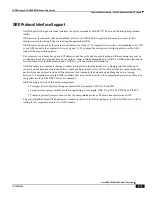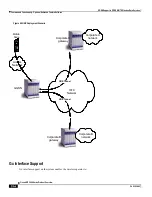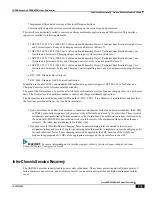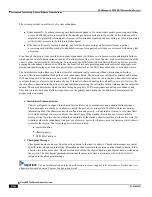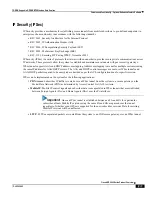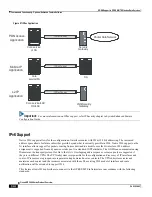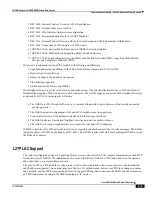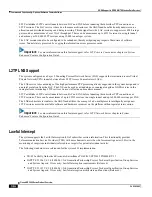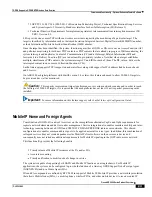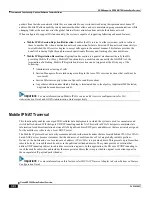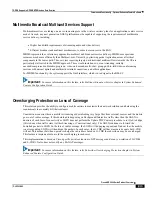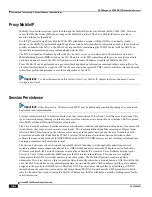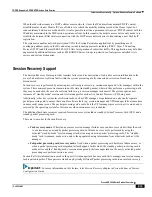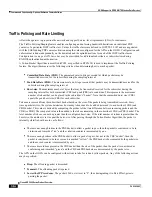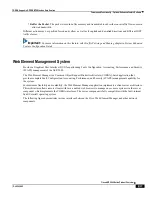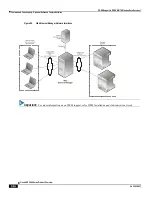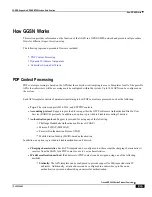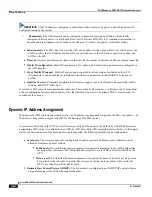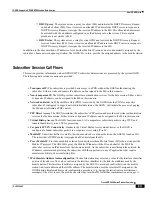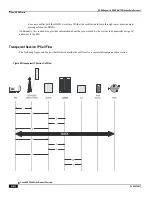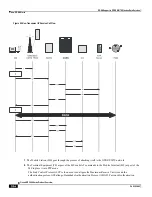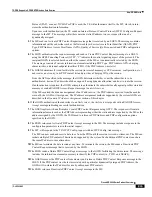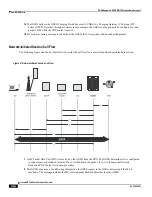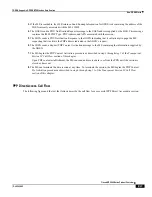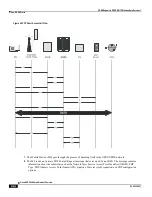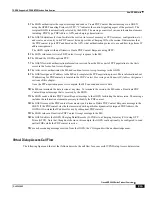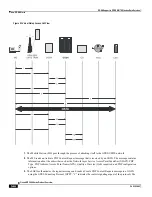
GGSN Support in GPRS/UMTS Wireless Data Services
Features and Functionality - Optional Enhanced Feature Software ▀
Cisco ASR 5000 Series Product Overview ▄
OL-22938-02
When the subscriber roams to a 3GPP cellular access network, it uses the IP address from normal PDP IP context
establishment as its new Mobile IP Care of Address to refresh the mobility binding record at the Home Agent. For
reduced latency between access hand-offs, it is also possible to utilize a permanent 'always-on' PDP IP context with the
IP address maintained in the MIP session persistence client. In this scenario, the mobile access device only needs to re-
establish the dormant RAB wireless connection with the 3GPP access network prior to transmitting a new Mobile IP
registration.
The system also enables network-provisioned VPNs for Session Persistence applications by permitting use of
overlapping address pools on the HA and using various tunneling protocols including IPSEC, Layer 2 Tunneling
Protocol (L2TP) and Ethernet IEEE 802.1Q VLANs for separation of subscriber traffic. This application may be further
augmented by additional features such as 800 RADIUS Server Groups to permit use of enterprise controlled AAA
servers and custom dictionaries.
Session Recovery Support
The Session Recovery feature provides seamless failover and reconstruction of subscriber session information in the
event of a hardware or software fault within the system preventing a fully connected user session from being
disconnected.
Session recovery is performed by mirroring key software processes (e.g. session manager and AAA manager) within the
system. These mirrored processes remain in an idle state (in standby-mode), wherein they perform no processing, until
they may be needed in the case of a software failure (e.g. a session manager task aborts). The system spawns new
instances of ―standby mode‖ session and AAA managers for each active Control Processor (CP) being used.
Additionally, other key system-level software tasks, such as VPN manager, are performed on a physically separate
packet processing card to ensure that a double software fault (e.g. session manager and VPN manager fails at same time
on same card) cannot occur. The packet processing card used to host the VPN manager process is in active mode and is
reserved by the operating system for this sole use when session recovery is enabled.
The additional hardware resources required for session recovery include a standby System Processor Card (SPC) and a
standby packet processing card.
There are two modes for Session Recovery.
Task recovery mode
: Wherein one or more session manager failures occur and are recovered without the need
to use resources on a standby packet processing card. In this mode, recovery is performed by using the
mirrored ―standby-mode‖ session manager task(s) running on active packet processing cards. The ―standby-
mode‖ task is renamed, made active, and is then populated using information from other tasks such as AAA
manager.
Full packet processing card recovery mode
: Used when a packet processing card hardware failure occurs, or
when a packet processing card migration failure happens. In this mode, the standby packet processing card is
made active and the ―standby-mode‖ session manager and AAA manager tasks on the newly activated packet
processing card perform session recovery.
Session/Call state information is saved in the peer AAA manager task because each AAA manager and session manager
task is paired together. These pairs are started on physically different Ppacket processing cards to ensure task recovery.
Important:
For more information on this feature, refer
Session Revocery
chapter in
System Enhanced Feature
Configuration Guide
.
Summary of Contents for ASR 5000 Series
Page 1: ......
Page 26: ......
Page 48: ...New In Release 10 0 SCM Features Cisco ASR 5000 Series Product Overview OL 22938 02 ...
Page 50: ......
Page 58: ......
Page 68: ......
Page 126: ......
Page 138: ......
Page 146: ......
Page 218: ......
Page 236: ......
Page 356: ......
Page 374: ......
Page 422: ......
Page 496: ......
Page 572: ......
Page 654: ......
Page 700: ......
Page 726: ......
Page 784: ......
Page 816: ......
Page 844: ......
Page 906: ......
Page 926: ......
Page 942: ......
Page 943: ...Cisco ASR 5000 Series Product Overview OL 22938 02 Chapter 30 Technical Specifications ...
Page 966: ......
Page 972: ......



